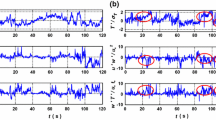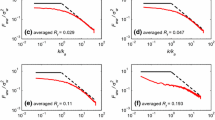Abstract
A correction model for eddy correlation flux measurements is developed and applied to nitrogen dioxide flux measurements obtained from a SOLENT sonic anemometer and a Scintrex Luminox LMA-3 analyser for NO2. Four field campaigns were carried out near the village of Merenschwand in Central Switzerland from which two were selected for further analysis in this paper. The need for the correction of measured eddy covariance fluxes arises due to the damping loss of the NO2 analyser at high frequencies. This damping loss is described by an analogy to inductance in an electronical alternating current circuit. The independent variables in the correction model are:z (measuring height above zero-plane displacement),\(\bar u\) (mean horizontal wind speed), ζ (Monin-Obukhov stability parameter),f (natural frequency) and inductanceL. The value for inductanceL can be derived from spectral and cospectral analysis. The theoretical cospectrum of an ideal measurement is taken from Kaimalet al. (1972) and extended with a damping term in order to describe the real measurements of the cospectrum. The inductanceL of the LMA-3 with a 0.6 cm teflon aspiration tube of 5 m length lies in the order of 0.30 to 0.35 for the dataset from Merenschwand. With this inductance, a correction factor of 1.17 in August/September 1992 and of 1.18 in May 1993 was determined for the NO2 flux maxima during daytime. The range of the correction factor is 1.05 to 1.31 for the mean daily cycles of both datasets.
Similar content being viewed by others
References
Businger, J. A.: 1986, ‘Evaluation of the Accuracy with which Dry Deposition can be Measured with Current Micrometeorological Techniques’,J. Climate and Appl. Meteorol. 25, 1100–1124.
Claussen, M.: 1985, ‘A Model of Turbulence Spectra in the Atmospheric Surface Layer’,Boundary-Layer Meteorol. 33, 151–172.
Grant, A. L. M. and Watkins, R. D.: 1989, ‘Errors in Turbulence Measurements with a Sonic Anemometer’,Boundary-Layer Meteorol. 46, 181–194.
Ellenberg, H.: 1990, ‘Ökologische Veränderungen in Biozönosen durch Stickstoffeintrag’, In:Ammoniak in der Umwelt — Kreisläufe, Wirkungen, Minderung, Darmstadt: Kuratorium für Technik und Bauwesen in der Landwirtschaft, 44.1–44.24.
Hesterberg, R.: 1994,Die Stickoxide im schweizerischen Mittelland und der Stickstoffeintrag in ein Naturschutzgebiet, PhD-Thesis, University of Bern (unpublished).
Hesterberg, R., Blatter, A., Fahrni, M., Rosset, M., Neftel, A., Eugster W., and Wanner, H.: 1995, ‘Deposition of Nitrogen-Containing Compounds to a Non-Cultivated Area in Central Switzerland’,Environmental Pollution, accepted for publication.
Hicks, B. B. and McMillen, R. T.: 1988, ‘On the Measurement of Dry Deposition using Imperfect Sensors and in Non-Ideal Terrain’,Boundary-Layer Meteorol. 42, 79–94.
Højstrup, J.: 1981, ‘A Simple Model for the Adjustment of Velocity Spectra in Unstable Conditions Downstream of an Abrupt Change in Roughness and Heat Flux’,Boundary-Layer Meteorol. 21, 341–356.
Kaimal, J. C. and Gaynor, J. E.: 1991, ‘Another Look at Sonic Thermometry’,Boundary-Layer Meteorol. 56, 401–410.
Kaimal, J. C. and Gaynor, J. E.: 1983, ‘The Boulder Atmospheric Observatory’,J. Climate and Appl. Meteorol. 22, 863–880.
Kaimal, J. C., Wyngaard, J. C., and Haugen, D. A.: 1968, ‘Deriving Power Spectra from a Three-Component Sonic Anemometer’,J. Appl. Meteorol. 7, 827–837.
Kaimal, J. C., Wyngaard, J. C., Izumi, Y., and Coté, O. R.: 1972, ‘Spectral Characteristics of Surface-Layer Turbulence’,Quart. J. Roy. Meteorol. Soc.,98, 563–589.
Leuning, R. and Moncrieff, J.: 1990, ‘Eddy-Covariance CO2 Flux Measurements Using Open- and Closed-Path CO2 analysers: Corrections for Analyser Water Vapour Sensitivity and Damping of Fluctuations in Air Sampling Tubes’,Boundary-Layer Meteorol. 53, 63–76.
Monin, A. S. and Obukhov, A. M.: 1954 ‘Osnovnye zakonomernosti turbulentnogo peremešivaniâ v prizemnom sloe atmosfery’,Trudy geofiz. inst. Akad. Nauk SSSR 24(151), 163–187.
Moore, C. J.: 1986, ‘Frequency Response Corrections for Eddy Correlation Systems’,Boundary-Layer Meteorol. 37, 17–35.
Panofsky, H. A.: 1978, ‘Matching in the Convective Planetary Boundary Layer’,J. Atmos. Sci. 35, 272–276.
Panofsky, H. A. and Dutton, J. A.: 1984,Atmospheric Turbulence, John Wiley & Sons, New York.
Panofsky, H. A., Larko, D., Lipschutz, R., Stone, G., Bradley, E. F., Bowen, A. J., and Højstrup, J.: 1982, ‘Spectra of Velocity Components over Complex Terrain’,Quart. J. Roy. Meteorol. Soc. 108, 215–230.
Philip, J. R.: 1963a, ‘The Theory of Dispersal during Laminar Flow in Tubes. II’,Aust. J. Phys. 16, 300–310.
Philip, J. R.: 1963b, ‘The Damping of a Fluctuating Concentration by Continuous Sampling through a Tube’,Aust. J. Phys. 16, 454–463.
Pilegaard, K., Hummelshøj, P., and Jensen, N. O.:Deposition of Ozone and Nitrogen Dioxide to Open Land and Forests, Contribution to the BIATEX Workshop Aveiro, May 1993, 1–8.
Purcell, E. M.: 1965, ‘Electricity and Magnetism’,Berkeley Physics Course Vol. 2, McGraw-Hill Book, New York, 274–295.
Skupniewicz, C. E., Kamada, R. F., and Schacher, G. E.: 1989, ‘Turbulence Measurements over Complex Terrain’,Boundary-Layer Meteorol. 48, 109–128.
Vilá-Guerau de Arellano, J. and Duynkerke, P. G.: 1992, ‘Influence of Chemistry on the Flux-Gradient Relationship for the NO−O3−NO2 System’,Boundary-Layer Meteorol. 61, 375–387.
Wyngaard, J. C. and Coté, O. R.: 1972, ‘Cospectral Similarity in the Atmospheric Surface Layer’,Quart. J. R. Met. Soc. 98, 590–603.
Zeman, O. and Jensen, N. O.: 1987, ‘Modification of Turbulence Characteristics in Flow over Hills’,Quart. J. Roy. Meteorol. Soc. 113, 55–80.
Author information
Authors and Affiliations
Rights and permissions
About this article
Cite this article
Eugster, W., Senn, W. A cospectral correction model for measurement of turbulent NO2 flux. Boundary-Layer Meteorol 74, 321–340 (1995). https://doi.org/10.1007/BF00712375
Received:
Issue Date:
DOI: https://doi.org/10.1007/BF00712375




